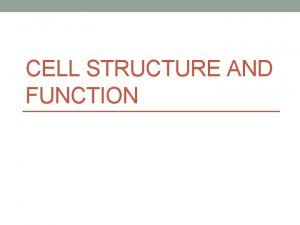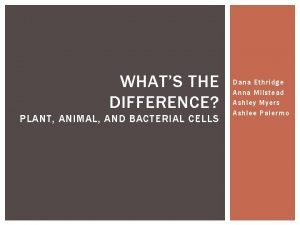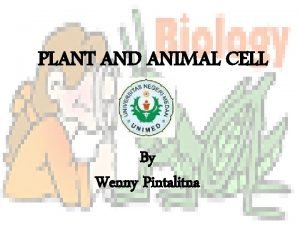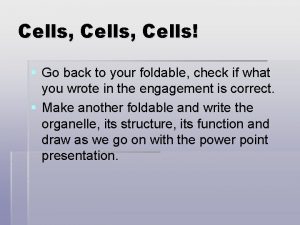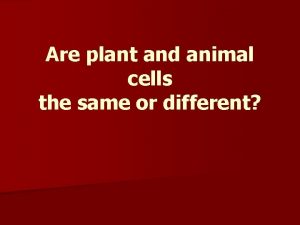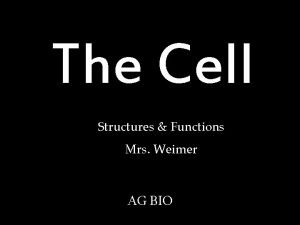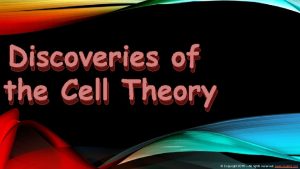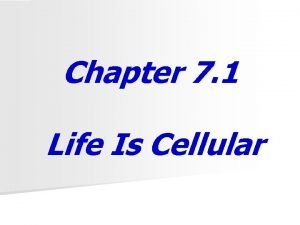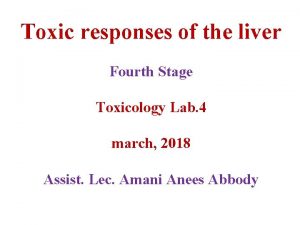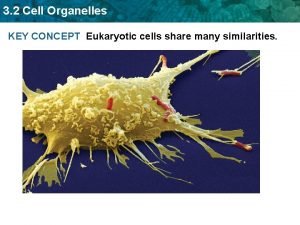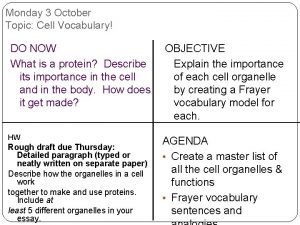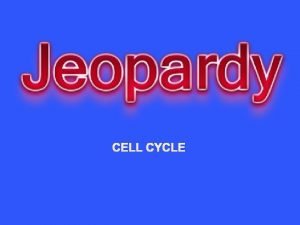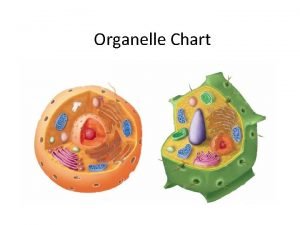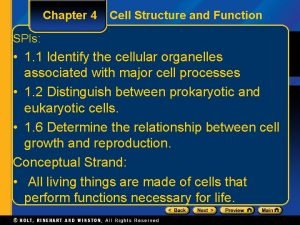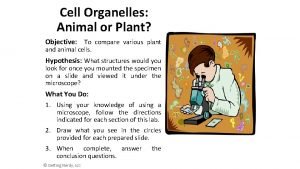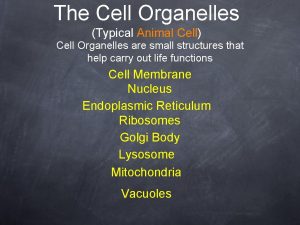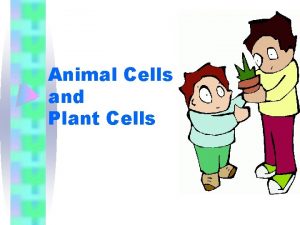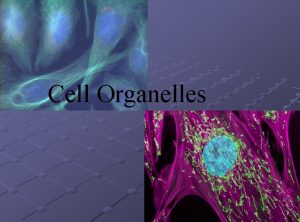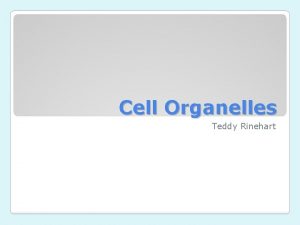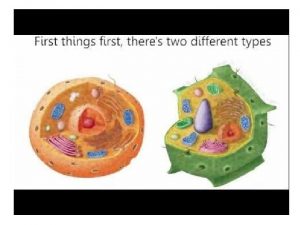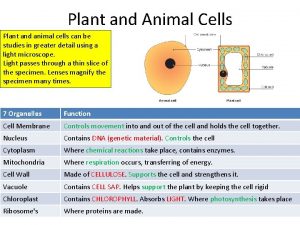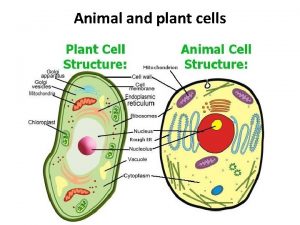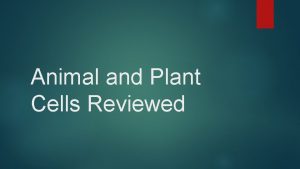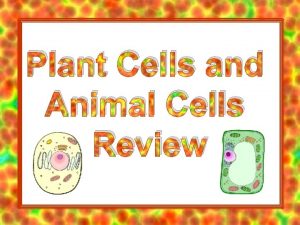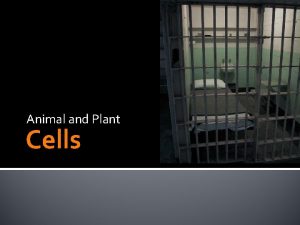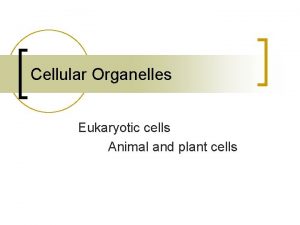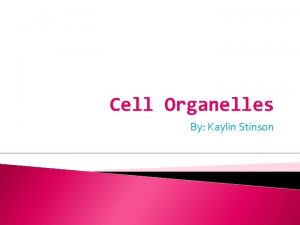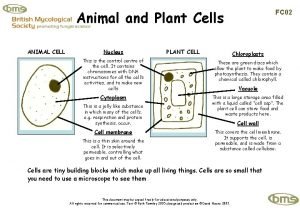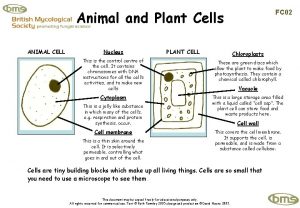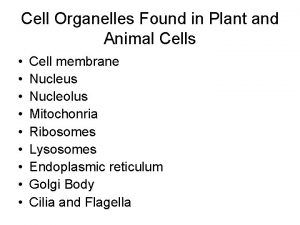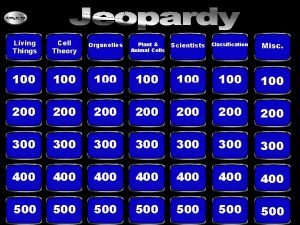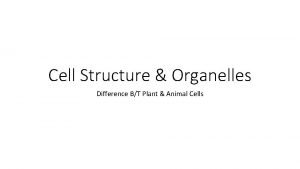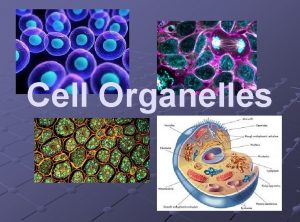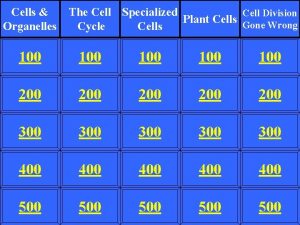Animal and Plant Cells and organelles Animal Cell





























- Slides: 29

Animal and Plant Cells and organelles

Animal Cell

Plant Cell

Nucleus control center of the cell

Nuclear Membrane the structure that surrounds the nucleus and controls what goes into or out of the nucleus

DNA and chromosomes structures inside the nucleus that store genetic information, which is information passed on from one generation to the next

Cell Membrane controls what goes into and out of a cell

Cytoplasm a thick gel-like substance that surrounds and supports the organelles inside the cell

organelles structures inside a cell

ribosomes organelles that produce proteins

Endoplasmic reticulum (ER) a system of membranes and sacs that can move materials from one part of the cell to another

Golgi bodies/apparatus/complex a system of membranes which changes, supports, and packages the proteins to be stored in the cell or secreted out of the cell

Lysosomes an organelle filled with enzymes that can digest organic compounds

Mitochondria the powerhouse of the cell which releases energy from food

Vacuole a saclike structure that stores water or wastes

Cell wall a stiff outer layer that surrounds the cell membrane of a plant cell

Chloroplast organelles which use the energy from the sun to make food for plants

DNA and chromosomes Cytoplasm Nucleus Nuclear Membrane Golgi bodies Endoplasmic reticulum ribosomes Vacuole Mitochondria Lysosome Cell Membrane

DNA and chromosomes Nucleus Nuclear Membrane Lysosome Golgi bodies Cytoplasm Endoplasmic reticulum Vacuole Mitochondria ribosomes Chloroplast Cell Membrane Cell wall

Vacuoles • Storage container for water, food, and wastes • Vacuoles are larger in plant cells than they are in animal cells

Differences in Cells • Usually the shape of a • Plant cells have some cell is related to its structures that animal function (job) cells do not – cell wall and chloroplasts • Plant cells have a boxlike shape and • A plant cell usually animal cells do not has one large vacuole have a particular and an animal cell shape usually has several small ones

Review • Which organelle directs all cell activities? Nucleus • Which organelle controls what goes into or out of the cell? Cell membrane • Which organelle controls what goes into and out of the nucleus? Nuclear membrane • What substance contains the instructions for everything the cell does? DNA

Ribosome • Smallest and most abundant organelles • Makes proteins • Proteins are very important for many of the cell’s activities

Cell Organelles • the parts inside a cell • they carry out functions (jobs) inside the cell

Cell Membrane • A thin, flexible barrier that surrounds a cell • Controls what goes into or out of the cell • Protects and supports the cell

Nucleus • “Control center of the cell” - Directs all cell activities • Usually the easiest organelle to see under a microscope • Cells with a nucleus (plant cells and animal cells) are called eukaryotes and those without a nucleus (bacteria) are called prokaryotes

Inside the Nucleus • Chromosomes – structures in the nucleus made of DNA • DNA – long, threadlike, material that contains the instructions for everything the cell does

Cell Wall • Found only in plant and bacterial cells • Rigid, protective barrier that protects and supports the cell • Found outside of the cell membrane of plant and bacterial cells

Chloroplast • Found only in plant cells • Contains the green pigment chlorophyll • Where photosynthesis takes place
 Difference of animal cell and plant cell
Difference of animal cell and plant cell Comparing plant and animal cells venn diagram
Comparing plant and animal cells venn diagram Cells and life lesson 1 answer key
Cells and life lesson 1 answer key Mitochondria double membrane function
Mitochondria double membrane function Tonoplast
Tonoplast Rough endoplasmic reticulum function
Rough endoplasmic reticulum function Idealized animal cell
Idealized animal cell What is the gooey liquid in plant and animal cells
What is the gooey liquid in plant and animal cells Plant and animal cells similarities
Plant and animal cells similarities Venn diagram of plants and animals
Venn diagram of plants and animals Plant and animal cells
Plant and animal cells How animal cells use nutrients
How animal cells use nutrients Plant and animal cells
Plant and animal cells Plant and animal cell foldable
Plant and animal cell foldable Whats the difference between plant and animal cells
Whats the difference between plant and animal cells Different parts of the animal cell
Different parts of the animal cell Difference between bacteria and plant cell
Difference between bacteria and plant cell Cell theory contributors
Cell theory contributors Chapter 7-1 life is cellular answer key
Chapter 7-1 life is cellular answer key Liver cells organelles
Liver cells organelles Organelles in eukaryotic cells worksheet
Organelles in eukaryotic cells worksheet Plant vs animal cells
Plant vs animal cells During interphase, a cell grows, duplicates organelles, and
During interphase, a cell grows, duplicates organelles, and Facts about vacuole
Facts about vacuole Which of the following pairs contains unrelated items?
Which of the following pairs contains unrelated items? Organelles graphic organizer
Organelles graphic organizer Cell organelle graphic organizer
Cell organelle graphic organizer Cell wall function
Cell wall function Animal cell structure under electron microscope
Animal cell structure under electron microscope Plant and animal cell objectives
Plant and animal cell objectives



